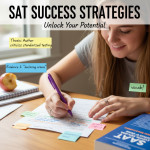Why Three Lenses? A Friendly Roadmap into Prose Analysis
When you sit down to read a short story or an excerpt for AP Literature, it helps to carry a few reliable lenses in your pocket — a way to focus your attention so the text stops being a blur and starts to hum with meaning. The three lenses we’ll use here are Character, Structure, and Narration. Separately each gives you insight. Together they make a map: character shows who the story cares about, structure shows how the story arranges events and emphasis, and narration shows who’s telling the story and how that shapes everything you see.

This blog is for the student who wants to move beyond surface impressions to rigorous, exam-ready analysis. You’ll get walkthrough strategies, concrete examples, a quick reference table for exam use, and study tips — including how Sparkl’s personalized tutoring can give you targeted practice and feedback to make these lenses second nature.
Lens One: Character — The Heartbeat of Prose
Character seems obvious — stories have people — yet AP prose questions often demand that you trace how character functions rather than merely summarize. Ask: What does the character want? What does the character believe about themselves or the world? How do choices reveal interior life? Who gets center stage, and who is backgrounded?
Active Reading Moves for Character
- Annotate desires and conflicts: Mark what a character explicitly wants versus what they implicitly seek (e.g., approval, safety, identity).
- Track changes: Note any shifts in priorities, coping strategies, or self-awareness; AP prompts often hinge on transformation.
- Watch relationships: Characters are shaped by other characters — allies, antagonists, mirrors. Relationship dynamics reveal motivation and theme.
- Distinguish action from interiority: List the protagonist’s actions and then list interior commentary or thought. The tension between the two often contains irony.
Example: Reading a Protagonist’s Arc
Imagine a short story where Maria refuses to attend her class reunion because of shame about a past mistake. On the surface this is a decision; through the character lens we probe: what does the refusal protect? Is it shame, pride, fear of exposure? Later, if Maria attends and confronts someone, the action isn’t just plot — it’s evidence of internal change. When you write about her, link actions to growth: “Maria’s decision to attend the reunion reframes shame into accountability, signaling a shift from avoidance to agency.” That causal phrasing is the kind of reasoning AP graders reward.
Lens Two: Structure — How the Story’s Architecture Shapes Meaning
Structure is not just chronology; it’s the order, pacing, and emphasis that direct your attention. Structure can create suspense, foreground memory, or compress time to emphasize a moment. On the AP exam, pointing to structural choices and explaining their effects separates a summary from an analysis.
Structural Features to Notice
- Chronology and flashback: Does the author start in medias res? Are memories scattered to create mystery or to mirror a character’s fractured mind?
- Paragraph and sentence length: Short sentences can quicken pace; long, winding sentences can slow you down and create reflection or overwhelm.
- Chapter or section breaks: Are these used to reset perspective, to create irony by juxtaposition, or to withhold information?
- Repetition and pattern: Repeated images or phrases can create motifs that knit structure to theme.
Example: Structure as Meaning-Maker
Think of a story that opens with an epigraph, then alternates between two time frames. The epigraph primes you — it’s like a lens on the first page. Alternation can make parallels: an earlier scene contrasts with a later one, highlighting growth or decay. If you claim, “The alternating sections allow the reader to witness how memory reframes the present,” be specific: name the sections, give a representative quote or paraphrase, and explain the rhetorical effect (e.g., deepens irony, evokes sympathy, increases tension).
Lens Three: Narration — Who’s Speaking and Why It Matters
Narration includes point of view (first-person, third-person limited, omniscient), voice (colloquial, formal, unreliable), and narrative distance (close or distant). Narration shapes what we know and how we feel about it. An unreliable narrator can create dramatic irony; a close third-person can grant intimate access to thought but still with authorial framing.
Quick Checklist for Narration
- Identify point of view and narrator reliability.
- Consider tone and diction — is the voice playful, moralizing, sardonic?
- Note narrative distance — how psychologically close are we to characters?
- Ask what knowledge is withheld and why the narrator would withhold it.
Example: Unreliable Narration
A first-person narrator who constantly excuses mistakes may be unreliable. When you analyze, point to patterns of minimization or omission: “The narrator’s repeated attempts to rationalize his behavior invite skepticism, prompting the reader to read between lines and question the presented moral frame.” Explain how this unreliability influences character perception and theme.
Putting the Lenses Together: Integrated Reading and Response
Strong AP essays synthesize the lenses rather than treat them separately. The structure creates conditions for character development; narration colors how we interpret both. When you prepare a response — whether timed in the exam or in practice — weave the lenses into a coherent claim.
Three-Step Approach to Build a Paragraph
- Claim: Make a concise analytical statement linking lens to effect. Example: “By using a fragmented structure and a limited third-person perspective, the author mirrors the protagonist’s fractured self.”
- Evidence: Offer a tightly quoted or precisely paraphrased example (one sentence or phrase from the text).
- Reasoning: Explain how the evidence illustrates the claim and connects to theme. Avoid plot summary; focus on cause and effect.
Mini Model Paragraph
Claim: The narrator’s retrospective voice complicates the protagonist’s moral accounting. Evidence: In the passage’s final lines, the narrator admits to exaggeration and glosses over the timeline. Reasoning: This confession recasts earlier confident assertions as potentially self-serving, inviting readers to reconsider moral clarity and exposing theme: memory is an instrument of self-justification. Such a paragraph ties narration to character and theme in three tight moves — exactly what AP readers look for.
Exam-Ready Table: Lenses, Questions, and Quick Strategies
| Lens | Key Questions | Fast Strategy in a Timed Setting |
|---|---|---|
| Character | What does the character want? How do actions reveal interiority? | Underline verbs and moments of decision; link them to desire or fear. |
| Structure | How is time arranged? What pacing or repetition stands out? | Map the excerpt’s sections quickly (beginning/middle/end) and note shifts. |
| Narration | Who tells the story? What knowledge is privileged or hidden? | Label the POV and scan for subjective language or authorial commentary. |
How to Turn Close Reading into a High-Scoring Essay
AP graders look for a few hallmarks: a clear thesis, well-chosen textual evidence, analytical reasoning that ties evidence to claims, and control of language. Here’s how to convert careful reading into a persuasive essay.
Start with a Precise Thesis
Don’t write a vague statement about “theme” — be specific about the interplay of lens elements. For example: “Through a constrained third-person viewpoint and a deliberately elliptical structure, the passage reveals the protagonist’s growing self-awareness and the instability of memory.” This nests narration (constrained third-person), structure (elliptical), and character (self-awareness) into one unified claim.
Choose Focused Evidence
Three strong citations are better than scattering ten weak ones. Choose moments where the author’s choices are visible: a telling line of dialogue, a structural pivot, a revealing interior sentence. Quote sparingly (one short quotation per paragraph is plenty), then explain — do not let quotes speak for themselves.
Explain Consequences
Effective analysis shows what the author achieves. After describing what a narrative choice does (e.g., narrows perspective), move to why that matters (e.g., generates empathy or suspicion, reframes theme). This move from device to effect is the engine of a high-scoring essay.
Practice Prompts and Responses — Try These
Practice under timed conditions using short excerpts. Below are sample prompts to train each lens and a combined prompt to build synthesis.
Prompt for Character
Read an excerpt where a character chooses not to speak at a crucial moment. Analyze how the author uses silence to reveal character. Consider interior thoughts, gestures, and the reactions of other characters.
Prompt for Structure
Read a passage that begins in the middle of an action and then shifts into a flashback. Explain how this arrangement affects the reader’s understanding of causality and blame.
Prompt for Narration
Analyze how point of view shapes our sympathy for a character. Is the narrator reliable? How does voice color the moral landscape of the excerpt?
Combined Prompt
Write an essay analyzing how character, structure, and narration work together in the passage to create a single dominant effect. Use specific references to the text.
Study Habits and Time-Saving Strategies
Preparing for AP Lit is both about building interpretive habits and practicing speed. Here are study strategies that help you internalize the three lenses and apply them reliably in an exam setting.
Daily Micro-Practices
- Daily 15-minute close reading: pick a paragraph and annotate for one lens only — rotate lenses across days.
- Flashcard device bank: each card names a structural or narrative device, defines it, and lists 1–2 effects it can produce.
- Peer discussion: explain one paragraph’s meaning out loud to a friend — teaching forces clarity.
Timed Practice
- 15-minute drills: read a 200–400 word excerpt and write a single-paragraph analysis focused on one lens.
- 40-minute essays: simulate the AP timed prompt once a week and then annotate mistakes.
How Personalized Tutoring Can Accelerate Your Progress
Many students plateau because they practice without targeted feedback. That’s where personalized tutoring helps. Sparkl’s personalized tutoring offers 1-on-1 guidance, tailored study plans, expert tutors, and AI-driven insights to show you exactly which lens needs work and how to build habits that stick. For example, if your essays show strong character analysis but weak structural reasoning, a tutor can design exercises that force you to practice identifying and explaining structural moves under time pressure.
What to Expect from Targeted Sessions
- Model essays and deconstruction: see exemplar paragraphs and break down why they score highly.
- Timed practice with feedback: learn to trade off speed and depth without sacrificing evidence or reasoning.
- Personalized device lists and practice prompts: focused materials aligned to your weakest skills.
Common Pitfalls and How to Avoid Them
Even strong readers fall into a few repeat traps on the AP exam. Here’s how to sidestep them.
Pitfall: Over-Summarizing
Don’t waste essay time retelling plot. If you must include context, keep it one sentence and move quickly to analysis. Always return to the text to support claims.
Pitfall: Vague Language
Avoid generic words: replace “the author shows” with precise verbs like “foregrounds,” “minimizes,” “fragments,” or “foregrounds.” Precise diction signals analytical thinking.
Pitfall: Device Dumping
Listing devices without connecting them to effects reads like a cheat sheet. Instead of naming five devices, show how one or two combine to produce a specific outcome.
Putting It All Together: A Study Week Blueprint
Here’s a practical weeklong plan to embed the three lenses into your reading practice. Make small, consistent moves rather than cramming.
- Day 1: Character focus — 2 short stories, annotate motivations and turning points.
- Day 2: Structure focus — analyze openings and section breaks in 2 excerpts.
- Day 3: Narration focus — assess POV and voice in first-person and limited third.
- Day 4: Combined practice — write two timed paragraphs integrating two lenses.
- Day 5: Timed full essay (40 minutes) and targeted review with a rubric.
- Day 6: Feedback day — review errors, rewrite essay, and note recurring issues.
- Day 7: Rest and light reading — read for pleasure with analytical curiosity.
Final Thoughts: Make the Lenses Your Habit
Character, structure, and narration are not separate subjects you study in isolation; they are conversational partners that, when used together, let you listen to what a text is trying to say. Practice the three-step paragraph (claim, evidence, reasoning), annotate with intentionality, and seek feedback that shows you what you still miss. If you want tailored guidance, consider Sparkl’s personalized tutoring: it helps turn your weaknesses into strengths through targeted drills, model analysis, and clear feedback loops.
Parting Tip
On exam day, breathe, read once for gist, then read again with one lens in mind. Jot the kernel of a thesis before you draft. A calm, lens-driven approach wins more points than frantic coverage of every device.

Keep practicing with intention, and let each paragraph you write be an experiment in seeing clearly. The prose exam rewards specificity and coherence — if you can say precisely how a narrative choice works and why it matters, you’re already doing the work of an expert reader.



















No Comments
Leave a comment Cancel